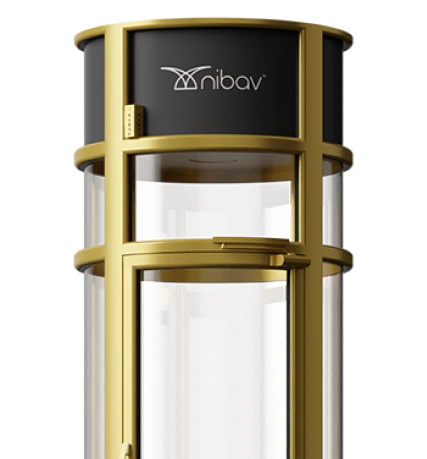Introduction—The Machine-Room-Less Elevators
The development of vertical mobility solutions has witnessed important changes throughout the years. Traditional manual lifts have advanced into hydraulic-driven elevators and escalators through an incredible transformation. Modern buildings demand improved, efficient, space-saving lift solutions, which resulted in the adoption of Nibav home lifts for buildings.
Implementing traditional home lifts vs. hydraulic lifts presents major operational difficulties. Home elevators demand space for machine rooms, need regular oil maintenance, and consume high energy.
Escalators require extensive spatial requirements in addition to their high electric power demands while presenting multiple safety hazards to users.
The market is being transformed through the introduction of Nibav air-driven home lifts. These lifts require no oil-related hardware, which leads to smaller designs and lower operational costs. This article evaluates how Nibav home lifts outperform hydraulic lifts and escalators in terms of functionality.
Understanding Nibav Home Lifts
The unique operating system of Nibav home lifts uses vacuum technology that depends on air pressure movement. These lifts differ from traditional hydraulic systems because they operate through an easy but powerful vacuum-based mechanism.
How Nibav Lifts Work
The Nibav lift system operates through its air-driven home lift technology to produce a vacuum that moves the cabin. The cabin rises as air pressure decreases above it and naturally returns to its original position due to gravity at no extra power cost.
Key features that distinguish Nibav Home lifts vs hydraulic lifts and escalators
- Space-saving Design – There is no requirement for a machine room or major structural adjustments.
- Eco-friendly Operation – Does not use oil-based hydraulic systems, which reduces environmental impact.
- Quick Installation – Can be completed in a few days without disturbing the building’s structure.
- Minimal Maintenance: It entails fewer mechanical parts and cheaper servicing expenses.
Benefits of Using Nibav Home Lifts Over Hydraulic Lifts
-
No Oil, No Mess
Hydraulic lifts face a significant disadvantage because they need oil-based system components. Hydraulic lifts work through connected pistons and cylinders that contain oil to achieve their operations. The leakage of this oil results in damage over time, which leads to expensive maintenance costs.
The leakage of hydraulic fluid into the building environment results in stained surfaces and ground contamination because the hydraulic fluid does not decompose naturally yet remains dangerous to the environment.
The vacuum system of Nibav air-driven home lifts fails to require either lubrication or oil. This means:
- Constructing Nibav air-driven home lifts eliminates oil leakage and oil spillage incidents.
- A cleaner and more eco-friendly operation.
- Reduced long-term maintenance costs.
The selection of Nibav lifts allows building owners and homeowners to avoid the environmental issues and operational disruptions of oil-based hydraulic systems.
-
Lower Maintenance
Building hydraulic elevators needs regular maintenance because the various mechanical elements in their pumps, pistons, and seals gradually deteriorate.
Regular maintenance checks must occur to prevent equipment breakdowns. Equipment breakdowns require long hours and generate significant maintenance expenses. No cooling systems exist to prevent malfunctions of hydraulic lifts since they easily become overheated.
A Nibav home lift designed for buildings features a practical, simple layout that contains a minimal number of components. The pneumatic system powering these lifts operates in a manner that produces minimal wear and tear, which leads to:
- Lower servicing and maintenance costs.
- Fewer breakdowns and technical issues.
- The Nibav home lift system delivers superior durability to regular hydraulic lifts.
Nibav lifts are convenient vertical mobility options that consume fewer resources and minimize maintenance costs for residential and commercial users.
-
Energy Efficiency
Traditional hydraulic elevator operation depends on powerful motors to shift elevator cabins. The large amount of electricity consumed drives up both the utility expense and power usage. Nibav home lifts for buildings have minimal energy requirements, thus producing impressive operational savings.
-
Compact & Space-saving
Separate machine rooms and large pits necessary for hydraulic lifts reduce available building space by occupying a significant amount of space. The Nibav lift system presents itself as a compact device that solves space issues by staying within small homes while avoiding extensive construction requirements.
Advantages of Nibav Home Lifts Over Escalators:
Commercial buildings often use escalators for vertical transport, although these systems present three key disadvantages: dangers to safety, high operational expenses, and significant space requirements. The Nibav home lift system provides improved safety with better efficiency while serving as an attractive addition to building interiors.
-
More Safety
Escalators are dangerous to all users because they allow accidents through slippery surfaces and create dangers from falls and gear entanglement, particularly to young people, elderly users, and individuals who wear loose clothing. The enclosed cabin of Nibav air-driven home lifts guarantees both security and zero occurrences of accidents.
-
Better Accessibility
The lack of wheelchair accessibility, combined with challenging usage by elderly people and people with heavy packages, makes escalators problematic for buildings. The Nibav lift system offers seamless vertical access to all users, including people with limited mobility, which qualifies it as an accessible option.
-
Aesthetic Integration
Massive design obstacles develop when escalators need space for installation in buildings, which may tamper with the planned architectural element. The modern designs of Nibav lifts match any interior setting and simultaneously improve the visual attractiveness of residential and professional spaces.
-
Cost-Effective Installation & Operation
Because of their intricate mechanical elements, escalators become expensive to install and maintain. Nibav home lifts provide buildings with minimal power consumption, reduced maintenance expenses, and fewer space requirements, which results in overall lower costs throughout the long term.
Why Nibav Home Lifts Are the Future of Vertical Mobility
Market Trends Favoring Pneumatic Lifts
The rise of urban areas combined with advanced smart mobility needs has made home lifts for buildings popular choices. The market shows growing interest in pneumatic lifts because of their capacity to conserve space and their energy-efficient characteristics.
Sustainability and Long-Term Cost Savings
Hydraulic lift maintenance requirements become unnecessary because air-driven home lifts operate sustainably without needing oil systems. Home lifts decrease both power usage and long-term maintenance costs associated with building maintenance and repairs.
The Role of Smart Technology
Today’s Nibav lifts incorporate smart technology to enable remote monitoring and implement improved security and automated operation features. Modern technological advancements make Nibav Home Lifts the leading candidates to become the primary choice for future vertical mobility systems.
Conclusion
The Nibav home lifts for buildings represent better options when compared to conventional home lifts vs hydraulic lifts, and escalators. The air-driven technology removes the necessity of oil, which enhances operational efficiency and cleanliness.
Services, space-saving designs, safety features, and reasonable operational costs make these devices optimal for modern buildings. The market’s emphasis on sustainability and innovation positions Nibav Lifts as the next-generation system for vertical movement.
Frequently Asked Questions
Why are Nibav home lifts better than hydraulic lifts?
Nibav home lifts vs hydraulic lifts offer cleaner, more efficient, and lower-maintenance solutions. They do not require oil, occupy less space, and have lower operating costs.
Can Nibav home lifts replace escalators in buildings?
Yes, Nibav home lifts offer a safer and more efficient option for buildings. They save space and cost less than escalators, especially for homes and small businesses.
How do Nibav home lifts improve safety compared to escalators?
Nibav air-driven home lifts are safer than escalators. They have a secure, enclosed cabin, which lowers the risk of entrapment and falls.
Are Nibav home lifts eco-friendly compared to hydraulic lifts?
Nibav lifts use less energy, need no oil, and release no harmful emissions, making them a greener option than hydraulic lifts.
Are Nibav home lifts cheaper than hydraulic lifts or escalators in buildings?
Yes, Nibav lifts cost less to install, need little maintenance, and use less energy. This makes them a smarter investment compared to hydraulic lifts and escalators.




